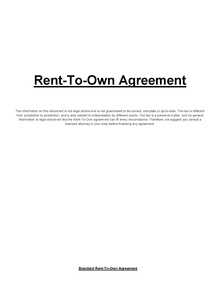Lease purchase contract
A Lease-Purchase Contract, also known as a Lease Purchase Agreement,[1] is the heart of Rent-To-Own properties. It combines elements of a traditional rental agreement with an exclusive right of first refusal option for later purchase on the home.[2] It is a shortened name for Lease with Option to Purchase Contract.

The typical contents of a Lease-Purchase Contract are:[3]
The Option Fee - The initial payment you need to make. This goes towards the down-payment for the property at the end of the lease.
Monthly Payment - How much you will be paying monthly.
Rent Credit - How much of your monthly payment will go to the eventual down-payment of the property at the end of the lease. It is strongly suggested you establish an escrow account to ensure the security of your rent credit.
Duration - Timeframe of the Lease-Purchase Agreement. Usually 2–3 years or more.[4]
Property Value - The locked-in sale price of the property. Tenant-Buyer and Seller usually agrees to keep the property value the same despite house market changes.
Terms and Rules - This section talks about other details of the Lease such as Property Taxes, home repairs, homeowner's association fee, etc.[5]
Transaction Structure.
In a standard Lease-Purchase Contract, the two parties agree to a lease period during which rent is paid, and the terms of the sale at the end of the lease period, including sale price. Often, the contract is structured in two parts, one representing the lease term and the other a contract of sale. The lease agreement expounds upon what responsibilities the tenant/buyer and landlord/seller undertake during the course of the lease. This contract will also include the option fee and how much of the monthly payment will be credited to the down-payment for the purchase of the home at the end of the lease.
At the end of the lease-term, the tenant/buyer has the option to purchase the house. The lump sum accrued from the initial deposit and the rent credit are only released to the buyer as down-payment on the house should the tenant/buyer decide to proceed with the purchase. The tenant/buyer is responsible for securing the necessary mortgage loan to finalize the purchase the home.
As is usually stated in the lease purchase contract, the option fee and accrued rent credit are both non-refundable should the tenant/buyer decide to walk at the end of the lease. The tenant/buyer is released from responsibility for the sale, and the landlord/seller is responsible for finding new tenants.
Should the tenant/buyer be unable to purchase the house due to a lack of financing, the tenant and landlord can agree to extend the option period, convert the lease purchase contract into a traditional rental agreement, or end the contract with the tenant moving out and the landlord seeking other renters or buyers.[6]
Benefits.
Lease-purchase contract agreements are open source in nature and flexible to the needs of the tenant/buyer and landlord/seller. Lease-purchase contracts are popular with tenant/buyers who have poor credit scores, lower savings for down payments, or people who are moving from one city to another but are pending a sale on their previous home. They are great for sellers who are having difficulty securing tenants for their properties, which can be common when a house is for sale.[7]
Difficulties.
Lease-purchase contracts are not for everyone. As successful completion of the agreement and sale transaction requires financing through a traditional route, people whose circumstances will not allow them to receive a mortgage should abstain from rent-to-own real estate agreements.
International Use.
UK.
Amid concerns about how long saving for a deposit takes young professionals, a POUND 400 million program was recently announced subsidizing rent at 20% for first-time homeowners. Subsidized rent prices lock in a period of time when the tenant-buyer saves, and the program requires sellers keep rent prices low to accommodate the process. At the end of the saving period, professionals have the option to purchase their flat. It now takes the average first-time buyer 22 years to save for a deposit without parental assistance.[8]
NZ.
Aukland’s Special Housing Area is subsidized by the Housing Foundation, providing homes for young families. Under their program, tenants pay rent on their homes for the first five years, then transition into paying mortgage payments. The Waimahia Inlet flagship development will see 282 new homes built over the next three years.[9]
NIGERIA.
The Lagos State Home-Ownership Mortgage Scheme (LagosHOMS) is a Rent-to-Own housing program that targets people who currently cannot afford a mortgage, but given till will be able to. Tenants are expected to pay rent for a period of time, after which they are invited to transition into mortgage payments. The program is designed with young professionals in mind, including teachers and junior public servants. The program has produced well over 200 new homeowners in the city.[10]
References
- ↑ http://homeguides.sfgate.com/write-lease-purchase-agreement-2737.html
- ↑ http://realestate.about.com/od/realestatebasics/p/lease_purchase.htm
- ↑ http://www.justrenttoown.com/blog/whats-lease-purchase-contract/
- ↑ http://www.biggerpockets.com/forums/52/topics/97211-what-is-your-average-length-of-lease-per-rental?page=1
- ↑ http://resources.lawinfo.com/landlord-tenant/essential-terms-for-a-lease-agreement.html
- ↑ http://money.usnews.com/money/personal-finance/articles/2014/01/22/is-rent-to-own-or-contract-for-deed-right-for-you
- ↑ http://www.forbes.com/2009/03/02/renting-mortgage-property-lifestyle-real-estate_rent_to_buy_slide_2.html?thisSpeed=30000
- ↑ http://www.dailymail.co.uk/news/article-2770614/Young-professionals-seven-years-cheap-rent-save-deposit-new-Government-scheme.html
- ↑ http://www.stuff.co.nz/life-style/home-property/10454687/Couple-thankful-for-rent-to-own-scheme
- ↑ http://businessdayonline.com/2014/07/lagoshoms-plans-rent-to-own-scheme-creates-193-jobs-for-project-firms/#.VC1-2vldWk8